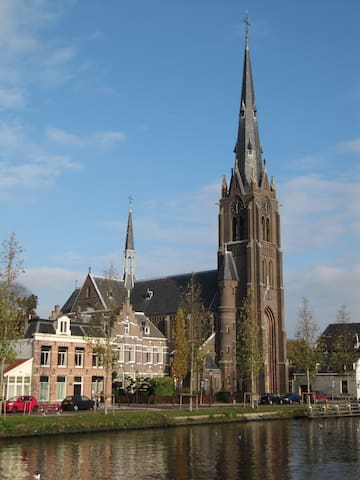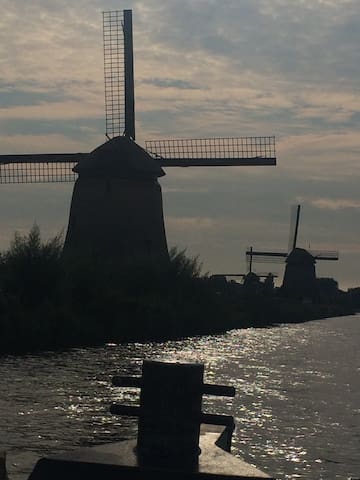Drinks, food & nightlife
Places to have dinner, lunch, espresso with a piece of cake. Or that locally brewed cold one!
Old church transformed into a beer brewery and gin-distillery! Well worth visiting!! Also good place to grab something to eat.
8 personas locales recomiendan
Wispe Brewery
16 HerengrachtOld church transformed into a beer brewery and gin-distillery! Well worth visiting!! Also good place to grab something to eat.
Nice trendy restaurant, grand cafe. Try the GT’s! Also very nice lunch menu.
9 personas locales recomiendan
De Eendracht Weesp
5 Het Grote PleinNice trendy restaurant, grand cafe. Try the GT’s! Also very nice lunch menu.
Busy place. Average age 18-30 years old. Cold beers, good music, nightlife of Weesp.
13 personas locales recomiendan
Toeters en Bellen
1 HerengrachtBusy place. Average age 18-30 years old. Cold beers, good music, nightlife of Weesp.
Café Almost Home
58 NieuwstadFunny setting... old chinese restaurant.
Dutch food. Dutch old setting. Like my boats :-)
Really friendly, young waiters. Decent priced. A lot of beers.
15 personas locales recomiendan
Café-Restaurant Aaltje
33 HerengrachtDutch food. Dutch old setting. Like my boats :-)
Really friendly, young waiters. Decent priced. A lot of beers.
Simple breakfast. A beer in the sun. if you are on time you can get something to eat as well.
Jachthaven "WSV de Vecht"
72 HoogstraatSimple breakfast. A beer in the sun. if you are on time you can get something to eat as well.
Try the GT’s! Good place for lunch! Probably also for dinner.
9 personas locales recomiendan
De Eendracht Weesp
5 Het Grote PleinTry the GT’s! Good place for lunch! Probably also for dinner.
Sightseeing
Here on a Saturday? I insist you visit (for free!!) the old windmill across the street. It's working on Tuesday and Saturday. But only on Saturday you are allowed to enter and climb the steep, 100+ year old wooden staircases to visit the interior of this antique windmill. The strongest one of The Netherlands. 4 mill stones.
And about Amsterdam: watch how the canals where made: https://www.youtube.com/watch?v=IvsHvfs3G1M
Here on a Saturday? I insist you visit (for free!!) the old windmill across the street. It's working on Tuesday and Saturday. But only on Saturday you are allowed to enter and climb the steep, 100+ year old wooden staircases to visit the interior of this antique windmill. The strongest one of The Netherlands. 4 mill stones.
14 personas locales recomiendan
Molen de Vriendschap
11A UtrechtsewegHere on a Saturday? I insist you visit (for free!!) the old windmill across the street. It's working on Tuesday and Saturday. But only on Saturday you are allowed to enter and climb the steep, 100+ year old wooden staircases to visit the interior of this antique windmill. The strongest one of The Netherlands. 4 mill stones.
Fortress dating back to 1200's. Very well preserved. Takes you back to the days of dungeons and dragons! I love to take you there on my private boat.
186 personas locales recomiendan
Muiderslot
1 HerengrachtFortress dating back to 1200's. Very well preserved. Takes you back to the days of dungeons and dragons! I love to take you there on my private boat.
Defense system of Amsterdam dating back to late 1800's. Now a very attractive fortress. A ferry goes up-and-down from Muiden. Depart next to Amsterdam Castle a.k.a. Muiderslot.
71 personas locales recomiendan
Fort Pampus
Defense system of Amsterdam dating back to late 1800's. Now a very attractive fortress. A ferry goes up-and-down from Muiden. Depart next to Amsterdam Castle a.k.a. Muiderslot.
Parks & Nature
It's just 5 (car-)minutes away, and you are swimming in crystal clear fresh water, surrounded by nothing but nature, islands, quietness.
Ask my were the secret beach is... Called 'Paradise'
7 personas locales recomiendan
Spiegel- en Blijkpolderplas
It's just 5 (car-)minutes away, and you are swimming in crystal clear fresh water, surrounded by nothing but nature, islands, quietness.
Ask my were the secret beach is... Called 'Paradise'
Very old forest. Attractive visitors centre with pretty good restaurant. Big playground for kids. Smal-, and big kids.
13 personas locales recomiendan
Natuurmonumenten
49 ZuidereindeVery old forest. Attractive visitors centre with pretty good restaurant. Big playground for kids. Smal-, and big kids.
Essentials
AH Achtergracht
64 AchtergrachtSupermarket. Close by...
Bakery Cor Muhl
64 NieuwstadBakery
Entertainment & Activities
Steven wil take you on a private tour in his classic tugboat build in 1923. Or you can use one of his canoes.
Steven's Drijfpaleis
Steven wil take you on a private tour in his classic tugboat build in 1923. Or you can use one of his canoes.
Bezienswaardigheden bekijken
The city centre of Weesp is as old as Amsterdam, but some 'Weespers' claim even older. It is also known as 'Little Amsterdam' because of its canals, bridges and restaurants, shops, bars and scenery.
Weesp was the main capitol in The Netherlands for its porcelain (china) and for the breweries of the dutch gin called 'jenever'. For this reason Weesp had several windmills to make the ingredients for jenever. One windmill, on the shore of the river is still in use and you can visit it every saturday. While it is working! dates back to 1654.
Weesp is already mentioned around 1150. Weesp then has great value because it is located on the border of Utrecht and Holland. Both areas are eager to incorporate Weesp. Poor Weesp is often attacked, burned down or deprived of food. In 1317 everything turned out fine, because then Weesp finally became Hollands. Count Willem V subsequently granted Weesp city rights in May 1355. So for anyone who doesn't know: never call Weesp a village.
Dutch Gin (jenever) and beer
The local economy of Weesp has long revolved around jenever and beer. Beer breweries in Weesp could use the clean water from the Vecht, but Weesp was mainly known for roasting jenever. From the 17th century onwards, jenever from Weesp was transported via the Amsterdam port to distant areas in the West and the East.
Van Houten
In 1850, Weesp's signature changed, thanks to the fact that the Van Houten cocoa factory moved from Amsterdam to Weesp. And much more than jenever and beer, the history of Van Houten is intertwined with that of Weesp. Consider, for example, Casparuslaan, named after Casparus van Houten Sr., just like Villa Casaparus. The historic city center with its many national monuments, including the Gothic Sint Laurens Church from 1462 and the special Van Houten church.
There used to be many mills here, three of which have been preserved. Korenmolen de Vriendschap still grinds grains using wind power.
This fortified city has two beautiful forts, Fort aan de Ossenmarkt and Fort Uitermeer. The Fort on the Ossenmarkt from 1861 defended the Vecht (river) banks, the locks and the Amsterdam-Amersfoort railway. The reason why this fort was built on this spot is because after the area was flooded, this railway, Vecht banks formed an entrance for the enemy to the area that the Netherlands defended. The railway was higher after the area was flooded, allowing the enemy to enter the area over it. The Vecht would be deep enough for the enemy to cross it with a boat. The locks were part of the water management system that ensured the flooding of the land for defense.
35 personas locales recomiendan
Weesp
The city centre of Weesp is as old as Amsterdam, but some 'Weespers' claim even older. It is also known as 'Little Amsterdam' because of its canals, bridges and restaurants, shops, bars and scenery.
Weesp was the main capitol in The Netherlands for its porcelain (china) and for the breweries of the dutch gin called 'jenever'. For this reason Weesp had several windmills to make the ingredients for jenever. One windmill, on the shore of the river is still in use and you can visit it every saturday. While it is working! dates back to 1654.
Weesp is already mentioned around 1150. Weesp then has great value because it is located on the border of Utrecht and Holland. Both areas are eager to incorporate Weesp. Poor Weesp is often attacked, burned down or deprived of food. In 1317 everything turned out fine, because then Weesp finally became Hollands. Count Willem V subsequently granted Weesp city rights in May 1355. So for anyone who doesn't know: never call Weesp a village.
Dutch Gin (jenever) and beer
The local economy of Weesp has long revolved around jenever and beer. Beer breweries in Weesp could use the clean water from the Vecht, but Weesp was mainly known for roasting jenever. From the 17th century onwards, jenever from Weesp was transported via the Amsterdam port to distant areas in the West and the East.
Van Houten
In 1850, Weesp's signature changed, thanks to the fact that the Van Houten cocoa factory moved from Amsterdam to Weesp. And much more than jenever and beer, the history of Van Houten is intertwined with that of Weesp. Consider, for example, Casparuslaan, named after Casparus van Houten Sr., just like Villa Casaparus. The historic city center with its many national monuments, including the Gothic Sint Laurens Church from 1462 and the special Van Houten church.
There used to be many mills here, three of which have been preserved. Korenmolen de Vriendschap still grinds grains using wind power.
This fortified city has two beautiful forts, Fort aan de Ossenmarkt and Fort Uitermeer. The Fort on the Ossenmarkt from 1861 defended the Vecht (river) banks, the locks and the Amsterdam-Amersfoort railway. The reason why this fort was built on this spot is because after the area was flooded, this railway, Vecht banks formed an entrance for the enemy to the area that the Netherlands defended. The railway was higher after the area was flooded, allowing the enemy to enter the area over it. The Vecht would be deep enough for the enemy to cross it with a boat. The locks were part of the water management system that ensured the flooding of the land for defense.



